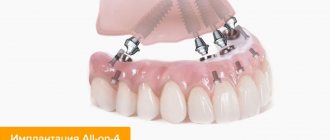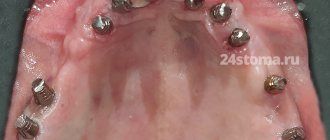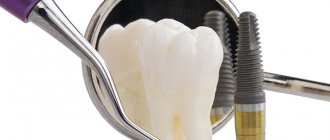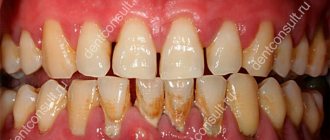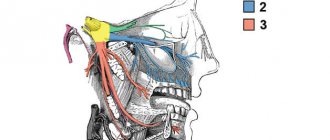Implantation is recognized as an advanced method for restoring lost teeth. This popular technique is used by dental centers all over the world. Manufacturers from different countries produce high-quality structures for implantation that restore the dentition and aesthetic qualities of a smile.
Many patients have heard about the benefits of installing implant systems, but not many know about the disadvantages of such treatment. In the article we will consider all the disadvantages of dental implants, reviews
patients and possible health risks after the procedure.
General information about the dental implant procedure
The essence of implantation is the restoration of a lost tooth or several units in a row by implanting an artificial root into the jaw bone, followed by installing a dental crown on the implanted pin.
Dental implantation takes place in several stages:
1. Examination and preparation of the patient’s oral cavity. In the presence of caries and other dental diseases, implantation is not performed. Initially, diagnostics are performed using hardware techniques, then the doctor carries out all the necessary treatment procedures to eliminate the identified diseases. If the patient has chronic diseases of various organs and systems of the body, he will also have to undergo an examination by specialized specialists, who must give an opinion on the possibility of safe dental implantation.
2. At the second stage, dental implants are implanted
. This is a surgical procedure performed under anesthesia during which the doctor implants an artificial root into the jaw bone and installs a temporary crown.
3. Several months should pass after the second stage. This time is allotted for the complete engraftment of the artificial root. If during this period the patient does not experience complications, the implantation is completed with the installation of a permanent crown. Externally, such a tooth cannot be distinguished from a real one. It also performs all chewing functions and withstands the various stresses associated with eating solid food.
Dental implants vary in shape, material and other technical parameters.
What are the types of dental implants
there are:
1. By installation method: intraosseous, extraosseous, mini-implants, cortical, basal, zygomatic.
2. By type of thread: compression, self-tapping, combined.
3. By type of material: titanium, zirconium, ceramic.
4. According to the size of the artificial root: short up to 10 mm, classic - within 20 mm, elongated - over 20 mm.
5. Shape: cylindrical, root-shaped, disk, combined, lamellar.
Before installing an artificial tooth, the patient needs to decide on the choice of implant, listening to the recommendations of the attending physician.
How often does the body reject an implant?
When dental implantology first appeared, cases of implant failure were common. This was due, on the one hand, to the little practical experience of the dentists of that time, on the one hand, and to insufficiently high-quality implants, on the other.
Nowadays, implant failure is extremely rare. Firstly, over half a century of the technology’s existence, enormous experience has been gained. Dentists at prestigious clinics almost never make mistakes during the preparation and performance of operations. Secondly, modern implants are made from biologically inert materials that the body does not perceive as something foreign. These are titanium, titanium alloys, and zirconium. Zirconium implants are the most expensive.
At the same time, there is still a negligible risk of implant rejection. This can happen due to the fault of an inexperienced surgeon, due to non-compliance with the doctor’s recommendations in the postoperative period, or due to emerging diseases.
What are the contraindications to the procedure?
Not every patient can have dental implants, due to a number of contraindications.
Contraindications to implantation:
- diabetes mellitus type II;
- cardiovascular pathologies;
- AIDS, HIV;
- hepatitis;
- open tuberculosis;
- bruxism;
- malocclusion;
- inflammatory diseases of the oral cavity;
- poor blood clotting;
- low immunity;
- mental illness;
- oncology;
- venereal diseases;
- allergic reactions.
Implantation is not performed during pregnancy, lactation, during exacerbation of chronic diseases, or in patients under 20 years of age.
Question 11. What is the expiration date of the implant?
The service life depends on the manufacturer of the artificial root. Let's look at the most common ones:
- Nobel Biocare (Switzerland-USA) – lifelong;
- Alpha Bio (Israel) – about 30 years;
- MIS (Israel) – lifelong;
- Straumann (Switzerland) – unlimited;
- XIVE (Germany) – lifelong;
- Biohorizons (USA) – unlimited;
- Astra Tech (Sweden) – about 40 years.
As you can see for yourself, most implants last a lifetime. Yes, they are an order of magnitude more expensive than prosthetic systems, but the implanted tooth will pay for itself with its reliability and durability.
In some cases, it may be necessary to replace the abutment or crown, but sometimes this work is covered by warranty.
How to choose an implant brand?
Rehabilitation period
After installation of the artificial root, a rehabilitation period begins, which is quite painful for the patient.
Symptoms that occur during the rehabilitation period:
- severe pain in the oral cavity;
- swelling and hyperemia of the gums;
- bleeding from gum tissue;
- increase in body temperature.
If the outcome is favorable, all of the above symptoms disappear a few days after the procedure. If relief does not occur, the pain intensifies, purulent discharge or other unfavorable symptoms appear, the patient needs to urgently visit the attending physician, as these signs indicate the addition of a bacterial infection.
Question 4: Is it possible to install several implants at once?
Yes, you can. But quantity plays a role. For example, surgeons place one or two artificial roots at a time.
It is always worth remembering that implantation is a surgical intervention and stress for the body. In order not to overload your health, the surgeon draws up an implantation calendar, where he clearly states the dates of operations. This will distribute the load on the body.
Note! There is no need to rush to insert all the missing teeth at the same time. Let this process be systematic. By waiting a few months, you will receive guarantees that the roots will take root reliably and withstand all the load that will fall on them.
What not to do after implantation?
After installation of a dental implant, the patient must responsibly follow all prescriptions and recommendations of the treating dentist.
Basic rules and prohibitions:
1. To avoid the development of infections in the oral cavity during the postoperative period, the patient needs to carefully care for the oral cavity, take medications as prescribed, avoid alcohol intake, and consume warm soft foods and drinks.
2. Avoid any physical activity for a week after implantation.
3. The dental implant must not be subjected to mechanical stress.
4. For some time after the procedure, you cannot visit the bathhouse or sauna; the patient must avoid overheating and hypothermia.
5. If the first signs of complications or implant rejection appear, immediately consult a doctor.
Installation of the healing abutment
When the doctor is sure that the implant has taken root, he will install a gum former for you. The name speaks for itself: the former is needed to prepare the gums for future prosthetics: installation of an abutment and crown.
Oleg, the operation took place in 2013:
“You know, after the operation and recovery, installing the shaper is just kindergarten, easy. It felt like a filling had been placed, at least in terms of time it was approximately like that. I spent 2 weeks with the former, and then they took impressions and put a crown on me within a month. Beauty!"
Approximate costs at this stage:
- Installation of a gum former: 5 thousand rubles
- X-rays (possibly) from 300 to 1200 rubles
Is it possible to do MRI diagnostics if you have a dental implant?
Many patients have the following question: is it possible to have an MRI with a dental implant?
? Dental implantation is not a contraindication to MRI diagnostics. Some structures made of non-inert metals may distort the results of the study.
In order for the diagnostician to correctly set up the MRI machine, the patient must show documents (special passport) received at the dental center, which will contain all the information about the installed dental implant.
Myth 2. “It's difficult. There is a risk of running into a non-professional, and then the implant will be rejected.”
Cases of rejection are extremely rare. Among implants in the middle price segment, successful engraftment occurs in 95-97.5% of cases, in the premium implant segment in 98-99% of cases.
Engraftment is affected by the patient’s compliance with the doctor’s strict recommendations.
Examples:
- Irregular brushing of teeth leads to the accumulation of plaque in the cervical area, which provokes inflammation of the gums. It spreads in the mouth, affecting the area where the implants are installed. The result is rejection.
- In addition to implanted teeth, the patient has prosthetic teeth, while the prosthesis “fits” poorly and constantly gradually injures the gums. This leads to reimlantitis.
- The patient forgot to tell the doctor that he was being treated at the cancer center. As a result, a course of radiation therapy leads to implant rejection.
There are many situations when a patient provokes (or does not prevent) the development of conditions for rejection. And the chances of this happening are higher than the chance of meeting with an amateur implantologist.
Oksana Melnikova, Moscow
“I was given an implant a long time ago, about 7 years ago, and it took root so successfully that I completely stopped distinguishing where I have real teeth and where I have artificial ones. Last year I did a hardware air flow cleaning, I liked the result, I promised myself to do it regularly. On one of my visits, I was “entrusted” to a young girl, apparently a trainee or intern, whatever they call it. She went over my gums thoroughly, so much so that the next morning they were swollen and itchy. Inflammation of the gums did not go away quickly (early spring, vitamin deficiency, all that), plus I didn’t start treating them right away, I just bought a soft brush and toothpaste for the gums. I thought it would pass. It did not pass. While I was getting ready to see the periodontist, I felt something was wrong; the implanted tooth on the lower jaw began to MOVE. After a month of futile attempts to save the implant, it was removed with pieces of overgrown bone. Simply creepy! Now I have had German bone material inserted, I’m waiting for it to take root and I will restore the tooth again. It’s a shame that there is no one to blame but yourself.”
Dental implantation at Aesthetics dentistry
Despite the disadvantages of implantation, this method of restoring lost units is still considered the best and most effective. The dental clinic employs highly qualified doctors who perform high-quality dental implantation with minimal risks of complications. This is confirmed by positive patient reviews.
The specialist conducts a competent examination of the patient’s oral cavity, studies personal history, and only then makes a decision on possible dental implantation, without adverse consequences for the patient.
The center uses high quality implants from the world's best manufacturers. All patients who leave reviews on the site are given a 3% discount on dental implantation and other dental procedures. The first consultation examination is free!
Does the reliability of structures really depend on their price?
According to the price segment, there are designs of three classes: premium, medium, economy. Premium implants have the highest price. They are made from high-quality materials - pure titanium and zirconium. Cheaper models are made from titanium alloys. Premium systems offer a wider range of application possibilities in different clinical cases - they are easier to install and have a wide selection of orthopedic elements. Therefore, their reliability compared to economical models is significantly higher.
Why is there a risk of rejection?
No manufacturer or dentist can claim that an implant will not be rejected 100%, since sometimes a complication occurs simply due to the body’s individual reaction to a foreign body.
The guarantee provided by dentistry is to protect the patient from complications in the event of rejection:
- due to a doctor’s error during installation (failure to comply with sanitary standards, incorrect installation, etc.);
- due to inconsistency of product quality.
If the patient did not follow the recommendations, or the implant was rejected after 2 - 4 years or more, then we are not talking about a medical error or poor quality. Most likely, pathological processes are occurring in the patient’s body, which become the cause. In such cases, the clinic, of course, does not bear responsibility.
Note! According to statistics, implants are rejected in only 2% of patients.
An implant is an imitation of a tooth with a root system.
The implant imitates only the main part of the tooth, which is visible from the outside, but it does not have a root system. Instead, all the main functions are performed by a special titanium pin, which is fixed in the tissues and holds the entire prosthesis.
There is simply no point in visually simulating the root system. Firstly, it is not visible (only on an x-ray). Secondly, it is enough to imitate the main part of the tooth.


